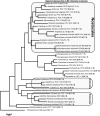Surveying DNA Elements within Functional Genes of Heterocyst-Forming Cyanobacteria
- PMID: 27206019
- PMCID: PMC4874684
- DOI: 10.1371/journal.pone.0156034
Surveying DNA Elements within Functional Genes of Heterocyst-Forming Cyanobacteria
Abstract
Some cyanobacteria are capable of differentiating a variety of cell types in response to environmental factors. For instance, in low nitrogen conditions, some cyanobacteria form heterocysts, which are specialized for N2 fixation. Many heterocyst-forming cyanobacteria have DNA elements interrupting key N2 fixation genes, elements that are excised during heterocyst differentiation. While the mechanism for the excision of the element has been well-studied, many questions remain regarding the introduction of the elements into the cyanobacterial lineage and whether they have been retained ever since or have been lost and reintroduced. To examine the evolutionary relationships and possible function of DNA sequences that interrupt genes of heterocyst-forming cyanobacteria, we identified and compared 101 interruption element sequences within genes from 38 heterocyst-forming cyanobacterial genomes. The interruption element lengths ranged from about 1 kb (the minimum able to encode the recombinase responsible for element excision), up to nearly 1 Mb. The recombinase gene sequences served as genetic markers that were common across the interruption elements and were used to track element evolution. Elements were found that interrupted 22 different orthologs, only five of which had been previously observed to be interrupted by an element. Most of the newly identified interrupted orthologs encode proteins that have been shown to have heterocyst-specific activity. However, the presence of interruption elements within genes with no known role in N2 fixation, as well as in three non-heterocyst-forming cyanobacteria, indicates that the processes that trigger the excision of elements may not be limited to heterocyst development or that the elements move randomly within genomes. This comprehensive analysis provides the framework to study the history and behavior of these unique sequences, and offers new insight regarding the frequency and persistence of interruption elements in heterocyst-forming cyanobacteria.
Conflict of interest statement
Figures




Similar articles
-
Molecular circuit of heterocyst differentiation in cyanobacteria.J Basic Microbiol. 2020 Sep;60(9):738-745. doi: 10.1002/jobm.202000266. Epub 2020 Jun 9. J Basic Microbiol. 2020. PMID: 32515850 Review.
-
The smallest known genomes of multicellular and toxic cyanobacteria: comparison, minimal gene sets for linked traits and the evolutionary implications.PLoS One. 2010 Feb 16;5(2):e9235. doi: 10.1371/journal.pone.0009235. PLoS One. 2010. PMID: 20169071 Free PMC article.
-
hetR and patS, two genes necessary for heterocyst pattern formation, are widespread in filamentous nonheterocyst-forming cyanobacteria.Microbiology (Reading). 2009 May;155(Pt 5):1418-1426. doi: 10.1099/mic.0.027540-0. Epub 2009 Apr 21. Microbiology (Reading). 2009. PMID: 19383713
-
Transcriptional regulation of development in heterocyst-forming cyanobacteria.Biochim Biophys Acta Gene Regul Mech. 2019 Jul;1862(7):673-684. doi: 10.1016/j.bbagrm.2018.04.006. Epub 2018 Apr 30. Biochim Biophys Acta Gene Regul Mech. 2019. PMID: 29719238 Review.
-
Genes of cyanobacterial origin in plant nuclear genomes point to a heterocyst-forming plastid ancestor.Mol Biol Evol. 2008 Apr;25(4):748-61. doi: 10.1093/molbev/msn022. Epub 2008 Jan 24. Mol Biol Evol. 2008. PMID: 18222943
Cited by
-
Comparative genomic insights into culturable symbiotic cyanobacteria from the water fern Azolla.Microb Genom. 2021 Jun;7(6):000595. doi: 10.1099/mgen.0.000595. Microb Genom. 2021. PMID: 34181515 Free PMC article.
-
Diazotrophs for Lowering Nitrogen Pollution Crises: Looking Deep Into the Roots.Front Microbiol. 2021 May 24;12:637815. doi: 10.3389/fmicb.2021.637815. eCollection 2021. Front Microbiol. 2021. PMID: 34108945 Free PMC article. Review.
-
Restoration of the Functional nif Gene Cluster by Complex Recombination Events during Heterocyst Development in the Nitrogen-Fixing Cyanobacterium Calothrix sp. NIES-4101.Plant Cell Physiol. 2024 Jun 27;65(6):1050-1064. doi: 10.1093/pcp/pcae011. Plant Cell Physiol. 2024. PMID: 38305573 Free PMC article.
-
CRISPR-Cas systems in multicellular cyanobacteria.RNA Biol. 2019 Apr;16(4):518-529. doi: 10.1080/15476286.2018.1493330. Epub 2018 Aug 15. RNA Biol. 2019. PMID: 29995583 Free PMC article.
References
-
- Mühling M, Harris N, Belay A, Whitton BA. Reversal of helix orientation in the cyanobacterium Arthrospira. J Phycol. 2003;39: 360–367.
-
- Kaplan-Levy RN, Hadas O, Summers ML, Rücker J, Sukenik A. Akinetes: dormant cells of cyanobacteria Dormancy and Resistance in Harsh Environments. New York, NY: Springer; 2010. pp. 5–27.
-
- Herdman M, Rippka R. Cellular differentiation: hormogonia and baeocytes. Methods Enzymol. 1988;167: 232–242.
Publication types
MeSH terms
Substances
LinkOut - more resources
Full Text Sources
Other Literature Sources
Miscellaneous

